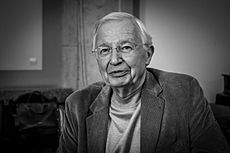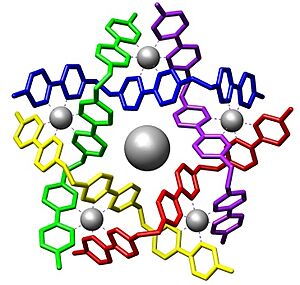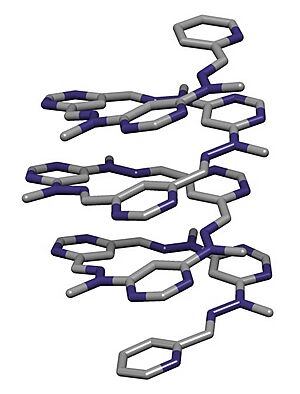Jean-Marie Lehn facts for kids
Quick facts for kids
Jean-Marie Lehn
|
|
|---|---|

Lehn in 2018
|
|
| Born | 30 September 1939 |
| Nationality | French |
| Alma mater | University of Strasbourg |
| Known for | Cryptands |
| Awards |
|
| Scientific career | |
| Fields | Supramolecular chemistry |
| Institutions |
|
| Thesis | Résonance magnétique nucléaire de triterpènes (1963) |
| Doctoral advisor | Guy Ourisson |
| Doctoral students | Jean-Pierre Sauvage |
Jean-Marie Lehn (born 30 September 1939) is a famous French chemist. He won the Nobel Prize in Chemistry in 1987. He shared this big award with two other scientists, Donald Cram and Charles Pedersen. They were all recognized for their amazing work on special molecules called cryptands.
Lehn was one of the first scientists to work in a field called supramolecular chemistry. This is a special type of chemistry that studies how different molecules fit together and interact. Think of it like tiny LEGO bricks that recognize each other and snap into place. This helps us understand how things work in our bodies, like how medicines "know" which cells to target. By January 2006, his research group had published 790 scientific papers about their discoveries.
Contents
Jean-Marie Lehn's Life Story
Early Life and Education
Jean-Marie Lehn was born in Rosheim, Alsace, France. His father was a baker who also loved music and became the city organist. Jean-Marie also loved music and played the organ, which he continued to do even after becoming a scientist.
He went to high school in Obernai from 1950 to 1957. There, he learned several languages like Latin, Greek, German, and English. He also became very interested in philosophy and science, especially chemistry. After high school, he decided to study science at the University of Strasbourg.
At the university, he joined the lab of Professor Guy Ourisson. Lehn worked hard and earned his Ph.D. He even helped set up the lab's first NMR spectrometer, a machine used to study molecules. His first scientific paper was about how different parts of molecules affect each other. After getting his Ph.D., he spent a year working at Harvard University in the United States.
A Career in Chemistry
In 1966, Lehn became an assistant professor at the University of Strasbourg. He focused his research on understanding the physical properties of molecules. He would create new molecules with specific shapes to see how their shape affected their behavior.
A big breakthrough came in 1968. He created special cage-like molecules that had a hollow space inside. These "cages" could trap other molecules. He could design these cages so that only certain types of molecules would fit inside. This idea was very important for creating new sensors and understanding how molecules work in living things, like in molecular biology.
Lehn called these cage-like molecules "cryptands." They became his main research focus. His work with cryptands led him to define a whole new area of chemistry: "supramolecular chemistry." Instead of just looking at the bonds inside one molecule, this new field studies how molecules attract and interact with each other. It also looks at "fragile objects" like micelles (tiny balls of soap molecules) or polymers (long chains of molecules).
In 1980, he was chosen to teach at the famous Collège de France. Then, in 1987, he received the Nobel Prize in Chemistry for his groundbreaking work on cryptands.
Later, in 1998, he started a research group at the Institute of Nanotechnology in Germany. He is also a member of the Reliance Innovation Council in India.
Lehn's Legacy
Jean-Marie Lehn's work has had a lasting impact on chemistry. In 1987, a famous composer named Pierre Boulez even dedicated a short piano piece to Lehn to celebrate his Nobel Prize.
Personal Life
Jean-Marie Lehn married Sylvie Lederer in 1965. They have two sons, David and Mathias. Lehn is an atheist.
Awards and Honors
Jean-Marie Lehn has received many important awards and honors for his scientific contributions.
- CNRS Gold medal (1981)
- Officer of the Ordre national du Mérite (1993)
- Grand Officer of the Légion d'Honneur (2014)
- Elected a Member of the United States National Academy of Sciences (1980)
- Humboldt Prize (1983)
- Nobel Prize in Chemistry (1987)
- Elected a Foreign Member of the Royal Society (1993)
- The Davy Medal of the Royal Society (1997)
- Austrian Cross of Honour for Science and Art, 1st class (2001)
- Knight Commander's Cross of the Order of Merit of the Federal Republic of Germany (2009)
- Order of the Rising Sun (Gold and Silver Star) of Japan (2019)
He has also received many honorary doctorates from universities around the world, recognizing his important work.
See also
 In Spanish: Jean-Marie Lehn para niños
In Spanish: Jean-Marie Lehn para niños



